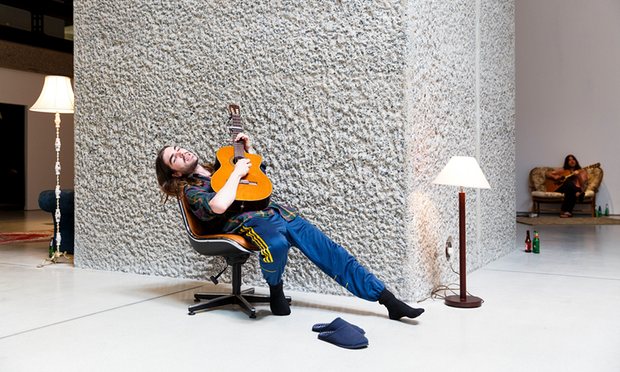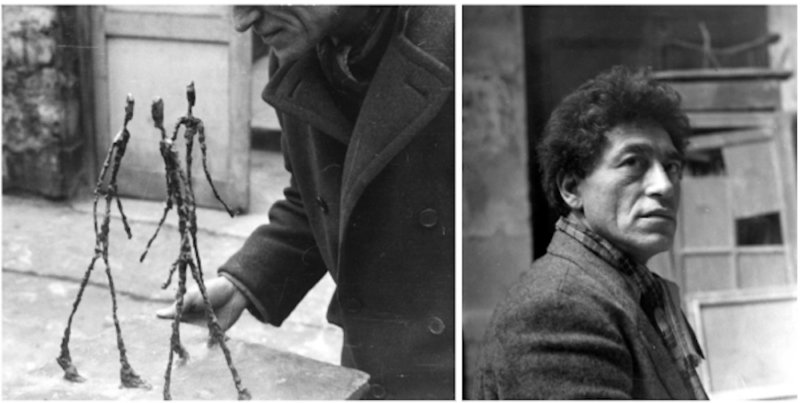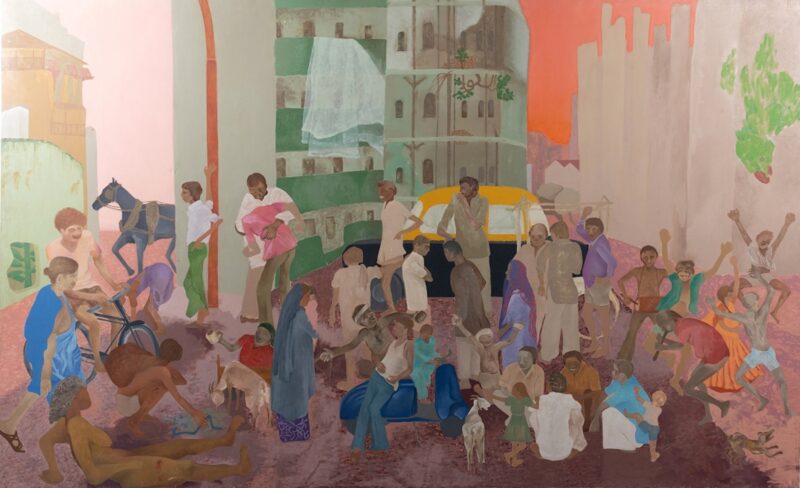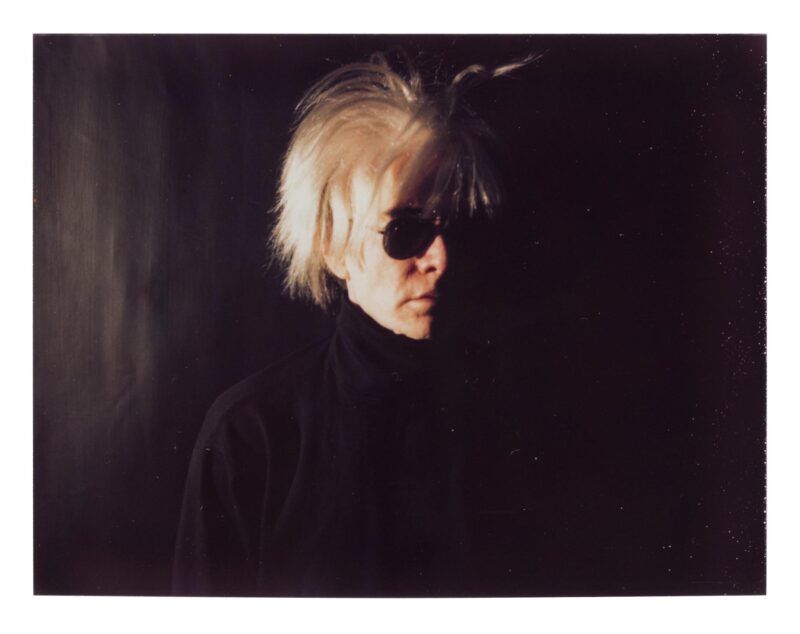
‘A gorgeously relaxed immersion’: an installation view of Ragnar Kjartansson’s show at the Barbican. Photograph: Tristan Fewings/ Getty Images
On the still waters of the Barbican lake drifts a boat bearing two girls in Edwardian costume. The reflection of their puffed sleeves and wasp waists makes a strangely familiar white blur. These are the summer beauties from many a Monet; indeed they are floating towards a waterlily reef. But it’s a scene fit for Courbet too, for these girls have cast aside the oars to lean together, lips meeting in a kiss.
It is the most sensuous surprise in the middle of this brutalist enclave. Passers-by stop walking to look. And this kiss goes on and on, so that the moment appears both endless and still – just like a painting, in fact.
Ragnar Kjartansson, who staged this vision, is one of the most brilliant artists at work today. Once seen, his art has true staying power. For many people, his white-sailed boat disappearing across the remotest harbour of the Venice Arsenale in 2013, carrying a crew of musicians performing an exquisite lament from dawn to dusk, was not just an unforgettable elegy for centuries of sailors crossing the bar but one of the most haunting spectacles in the history of the biennale.

Kjartansson had already performed there in 2009. The End involved smoking, drinking and painting hundreds of portraits of a fellow Icelandic performer round the clock to the bitter end of the biennale. Iceland was bankrupt, Venice was impenetrably grand, but still the artist must follow his calling, even if doomed to fail. It was a bittersweet parody of the romantic artist, and it touches on Kjartansson’s own life as a film-maker, musician, sculptor and performance artist who may only be playing the part of a painter.
All of his work has this gregariously social character, generally involving artist friends from Reykjavik, where Kjartansson was born in 1976 to an actress and theatre director. At the Barbican, both parents appear in a film clip from that same year, a fantasy sequence in which a bored housewife dreams of afternoon sex. The dishwasher has broken; the engineer arrives with his tools; take me now by the dishwasher, she mouths on the silent screen.
But the film’s dialogue has been transformed by Kjartan Sveinsson, ex-member of Icelandic rock band Sigur Rós, into a stupendous polyphonic score performed by minstrels strumming guitars around the gallery all day long. The music is ravishing, lapping around you in harmonious waves, and almost hypnotic in its melancholic roundelay, softening the film’s farce into sorrow.

It is a perfect start to this retrospective, representing so many aspects of Kjartansson’s work: his use of repetition and duration as a way to alter the meaning of words; his lament for lost love (his parents were later divorced) and unashamed address to the heart; above all, his peculiar fusion of humour and sorrow.
Here is a film of Kjartansson dressed as a Hollywood crooner, backed by a swoony orchestra, singing his one-phrase song – Sorrow Conquers Happiness – over and again to a shifting medley of music that makes the phrase seem more or less true or preposterous. Here is Kjartansson singing of his own failed marriage in the bath, while his guitar gets accidentally wet. Here is Kjartansson impersonating Death in a graveyard, impotently arguing about fate and loss with a group of passing children who accuse him of being nothing but an idiot with a cardboard scythe.
Guilt Trip shows the Icelandic comedian Laddi clad in black and trudging through a sublime snowbound wilderness like a figure out of Caspar David Friedrich – except that his wellingtons keep getting stuck and he repeatedly fires a gun without ever hitting a target. It’s a subtle essay on Laddi’s own elusive psychology and a tragicomic portrait of defeat and defiance.
Anyone entering the Barbican through the Silk Street entrance will have noticed the words “Scandinavian Pain” in pink neon across the facade, winking merrily at what is to come: a film of indie band the National singing their dirge Sorrow for six hours straight, for instance, so that the lyrics eventually become meaningless; a series of delicate stage sets of lonely cabins in Scandinavian white-outs; a video of the ideal Nordic interior, all blond panelling and gauzy white curtains, featuring the grandfather clock out of Munch’s tragic self-portrait Between the Clock and the Bed.
But this clock is slow, for it only chimes at five minutes past the hour, shattering the solemnity with mirth. Kjartansson has perfect timing.
The clock is one of a group of cinematic pictures, as he calls them – images skimmed from reality that are almost still, or almost timeless (Kjartansson has a fine disregard for the distinction between dimensions, construing films as performances and performances as pictures). Scenes from Western Culture is an array of idyllic vignettes: swimming in a Hollywood pool, dinner in a French restaurant, expensively dressed children playing in some German garden.
But the children’s ball goes awry, the swimmer is joined by a yapping Jack Russell, and the dinner conversation eventually stalls. These disintegrations are slow, but exponentially subtle.
The whole show is a gorgeously relaxed immersion in Kjartansson’s humorous, whole-hearted and generous way of thinking. His parents and friends reappear, cinematic landscapes are reprised as delicate watercolours, the minstrel’s music resurges between rooms. Images and sounds combine in roundelay, and nowhere is this more so than in the show’s absolute high point, the nine-screen installation called The Visitors.
This film was shot in one take at Rokeby Farm in upstate New York, a magnificently crumbling mansion full of gilded furniture and Roman busts. Each screen shows a lone musician performing in a separate room: a banjo player in the library, a drummer in the kitchen, a pianist in the salon and Kjartansson on guitar in the bath. Although they cannot see one another, each contributes to the same astonishing beautiful threnody for the artist’s lost marriage, lyrics supplied by his ex-wife.
It is a feat of timing and it slows down time, the music rising and falling from sumptuous gospel chorus to momentary silence. Exalted, romantic, exquisite to hear and to see, this cinematic and harmonic composition eventually becomes a portrait of the performers themselves – the withdrawn youth on the bass, his girlfriend turned away in the bed beside him; the cellist with her eyes rapturously closed; the abundantly suave pianist smoking a cigar while tinkling the ivories.
Like the fading rooms, redolent of long-ago parties, the music speaks of the fleeting youth and love embodied by the performers themselves. The longer you watch, the deeper the whole enchantment. One screen shows the villa’s exterior, where other guests sway to the music and the sound of crickets. Eventually the performers leave the building and walk away into the distance, still singing, disappearing like stars on the horizon.
For the broken-hearted, Ragnar Kjartansson offers consolation; for lovers he conjures a mirror of their blessed state. The Visitors is a marvellous creation, rhapsodic, mesmerising and overwhelmingly affecting. It runs for more than an hour but you could stay there for ever. I could not pull myself away.
• Ragnar Kjartansson is at the Barbican, London until 4 September
guardian.co.uk © Guardian News & Media Limited 2010
Published via the Guardian News Feed plugin for WordPress.







